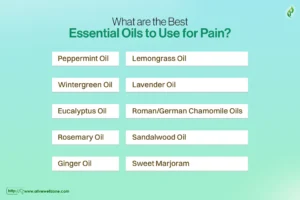
Last Updated on December 5, 2024 by Helena Akter
A variety of therapeutic properties of essential oils have gained significant attention in natural remedies. These concentrated botanical extracts promote good mood and relieve stress. In spite of their many benefits, one question persists: what is the strongest essential oil for pain?
The choice is dictated by the pain’s origin. For headaches, Peppermint or Lavender works well. For muscle cramps, try Sweet Marjoram. If you’ve got inflammation, use Helichrysum italicum. Also, recently Kunzea ambigua, an Australian oil, has shown efficacy in pain relief.
It’s no wonder individuals are seeking natural alternatives, looking for ways to relieve discomfort. To help you make informed decisions, we’ll explore all the candidates for the title of “strongest” pain-relieving essential oil.
Why Many Are Choosing Essential Oils for Pain and Inflammation Management?
Are you dealing with persistent or occasional pain, be it in the joints, or muscles, or due to chronic inflammation? Incorporating essential oils might be the next step in evolving your pain management strategy.
Now, essential oils are concentrated plant extracts that contain the roots, stems, leaves, and bark of plants, representing natural healing potential. These oils are more than just a fragrant addition! They’re a potent source of benefits harnessed through aromatherapy.
It’s not just about the pleasant aroma, it’s about the active compounds in these oils that are recognized for their medicinal properties. Here is how they could be beneficial —
- Alleviating pain and reducing discomfort
- Diminishing inflammation
- Enhancing immunity
- Calming the nervous system
- Mitigating anxiety
- Promoting emotional stability
- Improving sleep quality
- Relieving headaches
- Addressing allergy symptoms
Now, incorporating essential oils into a natural and well-rounded pain management routine could be a game-changer. And if you’re curious about where to apply essential oils for hormone balance, these oils could help balance hormones.
What are the Best Essential Oils to Use for Pain?
Well, it actually relies quite heavily on the particular source of your pain. Let’s explore some potent options that nature grants us —

Peppermint Oil
It’s regarded as one of the most potent natural remedies for soothing aches, it has earned a reputation for offering relief.
Wintergreen Oil
Sharing traits with peppermint, this oil is notable for containing methyl salicylate. However, you better consult with a healthcare provider if you’re on medications like blood thinners to avoid increased bleeding risks.
Eucalyptus Oil
Known for its anti-inflammatory properties, this oil can help ease joint and muscle discomfort. It holds promise even in addressing arthritis concerns.
Rosemary Oil
Acknowledged for its scientifically backed advantages, it’s known to lessen rheumatic disorder pains, and may even aid in mitigating backaches.
Ginger Oil
Researchers found ginger oil to be helpful for people with rheumatoid arthritis because of its anti-inflammatory properties.

Lemongrass Oil
Though primarily based on limited animal studies, it showcases the potential to diminish inflammation and the associated pain.
Lavender Oil
Often the highlight in aromatherapy, it can be your go-to option for headaches and muscle soreness, even extending its benefits to ease back pain.
Roman/German Chamomile Oils
These sought-after oils stand out in reducing inflammation and calming muscle camps. However, steer clear if you have a ragweed allergy, given their common botanical lineage.
Sandalwood Oil
Research points to its potential to be as effective as some common medications in reducing inflammation, thereby possibly easing back pain.
Sweet Marjoram
In case you’re experiencing muscle spasms, the antispasmodic properties of this oil could be just what you need.
While this guide might aid you in choosing the best essential oils for pain relief, remember, that individual reactions to oils can vary. So, it’s always best to consult with a healthcare provider for personalized advice.
Although it’s a topic for another day, interestingly, some even explore uses such as rosemary oil for eyebrows in their oil journeys.
Be Cautious with Essential Oil Use
Just a heads up — essential oils come in a highly concentrated form. It’s crucial to thin them out appropriately before using, and doing a skin patch test is a sensible step before you apply it liberally.
And remember, avoid contact with your eyes and mucous membranes.
Now, if you’re —
- Pregnant
- Nursing
- Dealing with a health condition
- Considering using it for children or elderly individuals
It’d be best to talk with a healthcare professional or a certified aromatherapist. They can even advise on a good muscle pain relief essential oil blend recipe.
So, be mindful of possible side effects, too. Like, we’re talking about skin irritations and being more susceptible to sunburns, and allergic responses.
Wrapping up
As we’ve journeyed through the world of essential oils, it becomes evident that nature has provided us with a variety of solutions. Each oil, with its unique composition, offers relief in its own distinctive way.
But pinpointing the single answer to the question of what is the strongest essential oil for pain is not straightforward. It may vary based on individual preferences, the nature of the pain, or even how one’s body reacts to specific oils.
Ultimately, while some essential oils may have more potent pain-relieving properties than others, it’s crucial to find what works best for you. Don’t forget to consult a healthcare professional before using essential oils as an alternative or complementary therapy.
These natural wonders can be a transformative experience for you, but it’s essential to do so with knowledge and caution.







